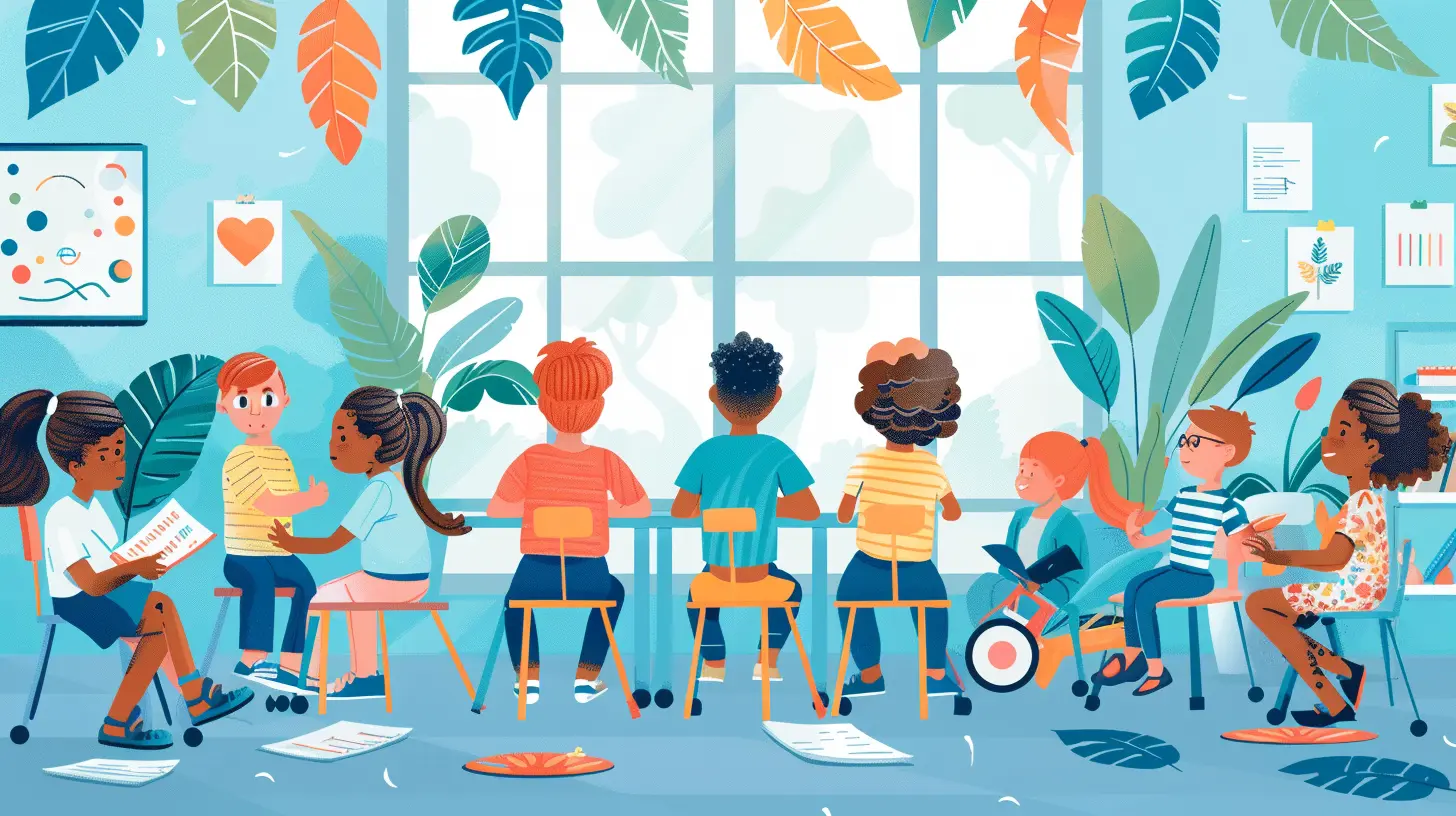The Benefits of Collaborative Learning in Inclusive Classrooms
26 July 2025
In today’s classrooms, diversity isn’t just a buzzword—it’s a daily reality. Inclusive classrooms, where students of all abilities and backgrounds learn side-by-side, are becoming the norm rather than the exception. And you know what? That’s a beautiful thing. But here’s the million-dollar question: how can we ensure that all students, regardless of their learning style or ability, truly thrive in such an environment?
The answer lies in something surprisingly simple yet incredibly powerful: collaborative learning.
Collaborative learning goes beyond the typical group project or peer discussion. It’s a dynamic, hands-on strategy that encourages students to work together, help one another, and grow in ways traditional instruction just can’t match. And when it’s done right, especially in an inclusive setting, the benefits are nothing short of transformative.

What Exactly Is Collaborative Learning?
Before we jump into the benefits, let’s break this down. Collaborative learning isn’t just any group work. It’s a structured way of learning where students team up to achieve a common goal, build knowledge together, and solve problems collectively. Think of it more like a team sport, where everyone brings their strengths to the field and together, they score the win.In inclusive classrooms, this means students with diverse needs—whether they have learning disabilities, are gifted, or are English language learners—are equally valued and actively involved in the learning process.

Why Inclusive Classrooms Matter
An inclusive classroom is more than just a mix of students with different abilities. It’s a space where every student feels like they belong—where their presence and participation are welcomed, appreciated, and encouraged. Inclusion isn’t about treating everyone the same; it’s about giving each student what they need to succeed.Now throw collaborative learning into the mix, and the magic begins.

1. Boosts Peer Relationships And Social Skills
Let’s face it: school isn’t just about academics. Social interaction plays a huge role in a child’s development. Collaborative learning creates opportunities for students to engage in meaningful interactions with their peers.When students work in groups, they learn how to:
- Communicate effectively
- Listen actively
- Respect different perspectives
- Resolve conflicts amicably
This is especially beneficial in inclusive settings. Students with social difficulties—say, those on the autism spectrum—can practice these skills in a low-pressure, supportive environment. Meanwhile, their peers gain empathy and understanding for others who may experience the world a bit differently.
Real-World Application
Ever worked in a team at your job? Collaborative learning mirrors real-life social dynamics kids will face beyond the classroom. It’s like a rehearsal for adulthood.
2. Encourages a Growth Mindset for All Students
You’ve probably heard the phrase “growth mindset” tossed around in education circles. It’s the belief that intelligence and abilities can be developed through effort, strategies, and help from others.Collaborative learning is a perfect way to instill this mindset. Why? Because it focuses on effort, communication, and progress—not just getting the “right” answer.
In an inclusive group, students see others overcoming obstacles and pushing through challenges. This exposure naturally encourages them to adopt a more resilient attitude toward learning.
3. Promotes Equity and Reduces Stigma
One major challenge inclusive classrooms face is the risk of students being labeled or feeling isolated because of their differences. Collaborative learning actively fights against that.By mixing students of varying abilities, backgrounds, and cultures, collaboration helps to blur these lines. Everyone contributes, everyone learns, and everyone benefits. No longer is a student “the one with the reading problem” or “the ESL kid.” In the group, they’re a valued teammate.
When students work together, they start seeing each other through the lens of shared goals rather than differences. That’s a game-changer for classroom culture.
4. Enhances Critical Thinking and Problem Solving
When students collaborate, they have to think critically—not just about the content, but about how to communicate their ideas, question each other’s assumptions, and come to a shared understanding.This process encourages:
- Deeper understanding of material
- Diverse ways of thinking
- Creative problem-solving techniques
In inclusive classrooms, this means that students benefit from different perspectives. For example, a student with ADHD might approach a problem in a way that others haven’t considered. That fresh take can open up new pathways for everyone in the group.
5. Builds Confidence and Independence
It might sound counterintuitive, but working in groups can actually help individual students become more independent. How? Because it gives them a safe space to speak up, test ideas, and take ownership of their learning.For students who are often hesitant or unsure—maybe because of a learning disability or language barrier—this kind of environment makes a huge difference. When their voice is heard and appreciated, their confidence soars.
6. Provides Authentic Assessment Opportunities
Here’s something you might not hear enough: collaborative learning is a goldmine for authentic assessment. Teachers can observe how students interact, solve problems, and explain their thinking. That kind of insight is hard to get from a multiple-choice quiz.In inclusive classrooms, this gives educators a deeper understanding of each student’s strengths, challenges, and learning needs. They can adjust instruction based on real-time feedback—something traditional assessments can’t easily offer.
7. Encourages Inclusive Teaching Practices
Let’s flip the script for a second and talk about teachers. Implementing collaborative learning nudges educators to rethink their practices. It pushes them to:- Differentiate instruction
- Create more engaging lessons
- Use student strengths to build understanding
This benefits everyone—not just students with special needs. The entire class gains from a more thoughtful, inclusive approach.
8. Prepares Students for a Diverse World
Our world is wonderfully diverse. Today’s students will live and work in environments filled with all kinds of people. Collaborative learning in inclusive classrooms gives them an early taste of that diversity.Students learn how to work with people who are different from themselves. They develop cultural competence, patience, and adaptability. These are not just “nice-to-haves”—they’re essential life skills.
9. Increases Student Engagement and Motivation
Let’s get real: nobody likes boring lectures. Kids, in particular, thrive on interaction. Collaborative learning gets them involved. When students are engaged, they’re more motivated to show up, participate, and put in the effort.In inclusive classrooms, this is critical. Students who might otherwise disengage—because they feel like they don’t belong or can’t keep up—find new reasons to be involved when learning becomes social and shared.
10. Supports Emotional Well-Being
Stress, anxiety, and low self-esteem are growing concerns in schools. Collaborative learning can play a role in addressing these issues.Working with peers helps students feel connected and supported. They realize they’re not alone in their struggles. For some kids, this emotional boost can make the difference between dreading school and actually looking forward to it.
Quick Real-Life Example
Imagine a student with dyslexia who struggles to read aloud. In a collaborative setting, she might be paired with a student who’s great at reading but struggles with organizing ideas. Together, they help each other—and both leave feeling more capable and empowered. That’s the magic of collaboration.Tips for Implementing Collaborative Learning in Inclusive Classrooms
Thinking this all sounds amazing but wondering how to actually make it work? Here's how:1. Build a Culture of Respect
Set the tone from day one. Students need to understand that everyone has something valuable to offer.2. Use Flexible Grouping
Mix students up regularly so they get to work with different peers and experience diverse perspectives.3. Provide Clear Roles and Expectations
Make sure everyone knows what they’re responsible for. Structure supports success.4. Scaffold the Process
Offer sentence starters, graphic organizers, and other tools to help all students participate meaningfully.5. Monitor and Mentor
Don’t just assign the group task and walk away. Check in, coach, and celebrate progress.
Final Thoughts
Inclusive classrooms are a reflection of the real world—beautifully diverse, complex, and full of potential. When you bring collaborative learning into these environments, you tap into something truly powerful.It’s not just about boosting test scores or checking boxes. It’s about building a learning community where every student feels seen, heard, and valued. It’s about preparing kids, not just for college or exams, but for life.
So next time you’re tempted to go the traditional lecture route, consider this: What if your classroom could be a place where every student, no matter their ability, worked together to create something meaningful? That’s the power—and the promise—of collaborative learning in inclusive classrooms.
all images in this post were generated using AI tools
Category:
Inclusive EducationAuthor:

Fiona McFarlin
Discussion
rate this article
1 comments
Indigo Wolfe
Collaborative learning: where diverse minds unite to shatter the status quo! Inclusive classrooms aren’t just a trend; they’re a revolution. Embrace the chaos, because teamwork makes the dream work—just ask the future leaders we’re cultivating!
August 7, 2025 at 12:37 PM

Fiona McFarlin
Absolutely! Collaborative learning harnesses diverse perspectives, fostering innovation and leadership in inclusive classrooms. It's a transformative approach that truly empowers all learners.


